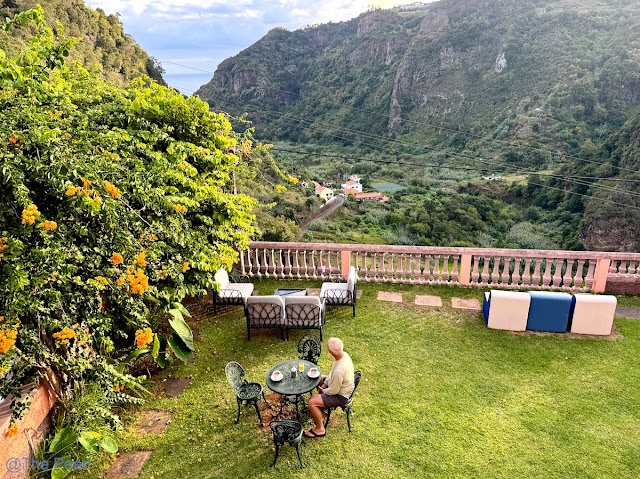“If you never go, you’ll never know.” –Unknown
Archive | The Pearl RSS feed for this section
Sept. 14 – Exploring the Southern Coast of Madeira
Sept. 14 – Exploring the Southern Coast of Madeira
“If you never go, you’ll never know.” –Unknown
The color of the water was so blue and it was so clear. Amazing!
What we saw and how it looks during the rainier season.
We could see the lighthouse from this little hike.
Ponta do Sol. The beach is so rocky they had a boardwalk to walk on and wooden pallets to sit on.
What a view. We had our first Prego sandwich. A Madeirian traditional steak sandwich. So good.
This is the Sol Poente Restaurant where we had lunch. If you look close you can see the blue deck we were sitting on that hung over the water.
Even with little sunshine the water looked inviting…so clear and blue.
Looking down through the glass floor.
Looking towards Funchal.
Stan and his buddy Winston Churchill. He liked visiting Madeira and spent his days painting. He would set up his easel and canvas and paint the bay of Câmara de Lobos in oil.
The boats were beautiful.
The streets in Câmara de Lobos are filled with art.
We went to dinner at a little place on Rua da Santa Maria called Galeria. Stan had Tropical scabbard fillet with passion fruit and banana and I had the Risotto with mushrooms and truffle oil. The food in Madeira is very good and very reasonably priced. Most dinners were under $50 including cocktails.
We went to a roof top bar for a nightcap. Another wonderful view.
We ended our long day by sitting on our little patio listening to a concert in the park across the street.
Tunnels in Madeira
Sept. 20 – Levada do Caldeirão Verde Hike
Sept. 19 – Porto Moniz, Portugal
“Life is better when it’s more important to know the tide than the time.” –Unknown
Sept. 18 – Exploring the Northern Coast of Madeira
“If you find yourself having to tiptoe around others, you’re not walking amongst your tribe.” -Tanya Markul
Sept. 16 – Monte in Funchal, Portugal
The view from the bell tower of the church.
Watching the toboggan action from the church.
We decided against doing the toboggan since the lines were so long. But it was fun watching them.
Funchal has so many little cafés along the narrow streets…so many good cafés. To celebrate Stan’s birthday we ate at O Visconde (The Viscount). The service and good was wonderful.
We tried a few different things. Seafood is a big thing in Madeira and it is very fresh. We started with the octopus salad, which was very good. Stan had sardines and I had the carbonara. We also had a bottle of wine and the bill only came to $44.50.
Sept. 13 – Funchal, Portugal
“All our dreams can come true if we have the courage to pursue them”. – Unknown
Sept. 13 – Funchal, Portugal
“All our dreams can come true if we have the courage to pursue them”. – Unknown
Just a few of the doors we saw. We went back to this little street the next night for dinner.
Sept. 15 – Porto da Cruz, Portugal
They serve ponchas at several stands. Poncha is the local rum punch…it has a lot of punch.
Hydrangeas grow everywhere here on the island. So pretty.
Once you get up into the mountains the scenery looks a lot like that in NY and PA.
Volcanic peaks are everywhere.
Looking east along the beach in Porto da Cruz. A popular surfing spot in Madeira.
Looking west at some of the little cafés along the harbor.
Lunch at The Wave.
Porto da Cruz Swimming Pool
Looking back to town from the seafront promenade.
The seafront promenade.
Companhia dos Engenhos do Norte (Northern Mills Company) is a working rum refinery. It’s the only working steam powered rum distillery left in Europe. It is located on the west side of the promenade.
You can tour their facility and do tasting in their little store.
One of the best meals we had all week was at India Gate. Stan had the Chicken Tikka Masala – Boneless chicken tikka cooked in yogurt, ginger, garlic, tomato, and a touch of garam masala. I had Chicken Curry – Chicken stewed in an onion and tomato based sauce, flavored with ginger, garlic, chili peppers and a variety of spices.






































































































































































